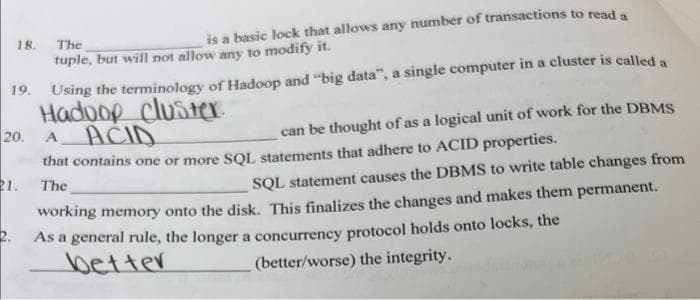18. The 19. 20. is a basic lock that allows any number of transactions to read a 21. tuple, but will not allow any to modify it. Using the terminology of Hadoop and "big data", a single computer in a cluster is called a Hadoop cluster. A ACID can be thought of as a logical unit of work for the DBMS that contains one or more SQL statements that adhere to ACID properties. The SQL statement causes the DBMS to write table changes from working memory onto the disk. This finalizes the changes and makes them permanent. As a general rule, the longer a concurrency protocol holds onto locks, the 2. better (better/worse) the integrity.
SQL
SQL stands for Structured Query Language, is a form of communication that uses queries structured in a specific format to store, manage & retrieve data from a relational database.
Queries
A query is a type of computer programming language that is used to retrieve data from a database. Databases are useful in a variety of ways. They enable the retrieval of records or parts of records, as well as the performance of various calculations prior to displaying the results. A search query is one type of query that many people perform several times per day. A search query is executed every time you use a search engine to find something. When you press the Enter key, the keywords are sent to the search engine, where they are processed by an algorithm that retrieves related results from the search index. Your query's results are displayed on a search engine results page, or SER.
Please send me answer of fill the blanks each with explanation please .sewbd me immiditely i will give you like

Step by step
Solved in 6 steps


